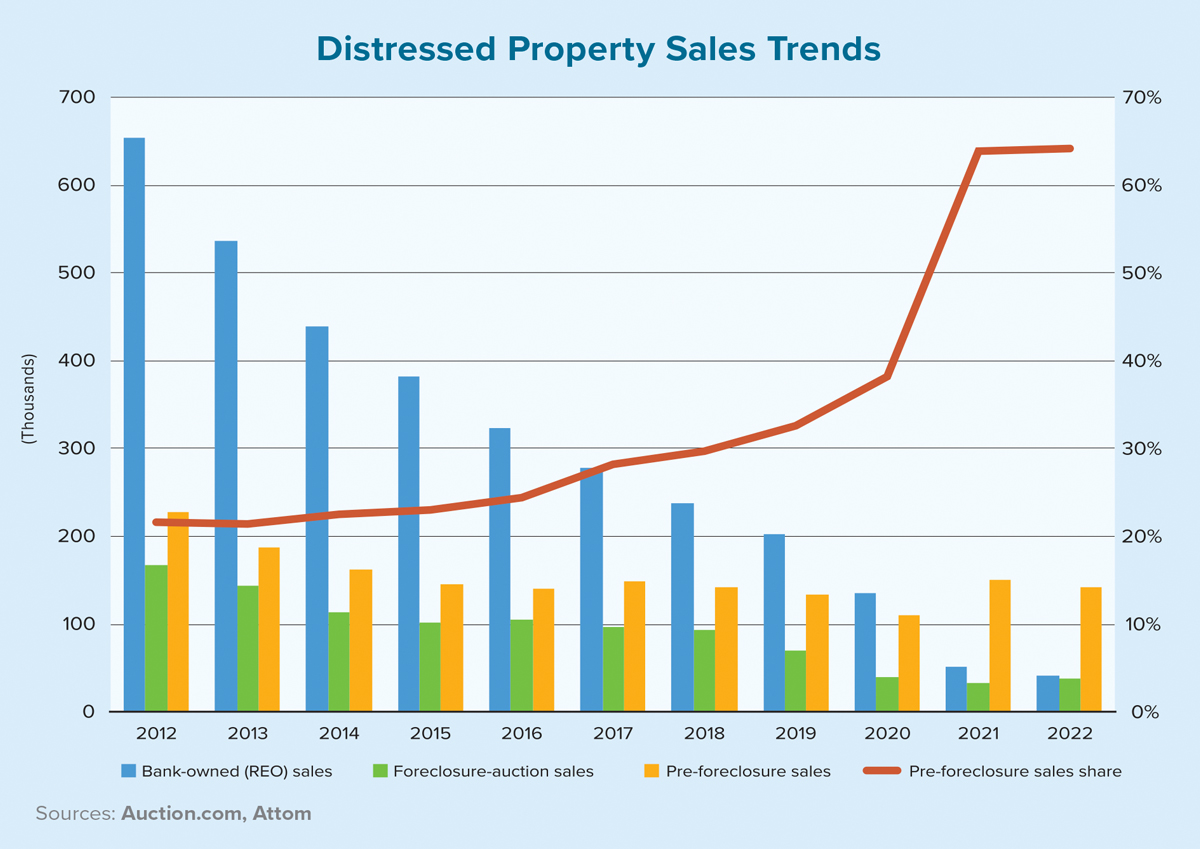A year ago, Auction.com’s 2023 outlook for the distressed housing market called for 112,000 to 175,000 completed foreclosure auctions for the year, with a possibility of up to 278,000 based on a potential recession, job losses and home price declines. Instead, the year is on track to finish with fewer than 100,000 completed foreclosures.
The disappearing distress of 2023 is an important mystery to solve. It will shed light on what to expect in the distressed market of 2024, which in turn has important implications on the broader retail housing market.
The first step in solving the puzzle of the disappearing distress is fairly straightforward: the monthly conversion rate of seriously delinquent mortgages to completed foreclosures. In the pre-pandemic era of 2015 to 2019, this monthly conversion rate averaged 1.96%, according to an Auction.com analysis of data from the Mortgage Bankers Association and Attom.
It’s helpful to put this metric in context. Given 1 million seriously delinquent mortgages, one could expect 19,600 completed foreclosure auctions per month and about 235,200 completed foreclosure auctions per year.
But the monthly conversion rate dropped dramatically in the final three quarters of 2020 and all of 2021, averaging 0.27% over these seven quarters. That’s not too surprising given the nationwide foreclosure moratorium on government-backed mortgages in place at that time. What’s more surprising is the post-moratorium conversion rate, which has averaged 0.71% since January 2022, although it has slowly inched higher over this period.
Why did the conversion rate decline? One would expect it to bounce back to its pre-moratorium average quite quickly, and possibly to rise above that average temporarily due to a backlog of delayed distress tied to the moratorium. That is, in fact, exactly what happened in the aftermath of the hurricane-induced foreclosure moratoriums of 2017.
But the post-pandemic moratorium rebound has been anemic at best, a result of at least two major changes in the distressed-market funnel. The first change is the massive increase in foreclosure prevention resources made available to mortgage borrowers and servicers during the pandemic that still continue in some form. On the loss-mitigation side, the most prominent resource that has gained widespread adoption is the zero-interest second mortgage that can be used to prevent payment shock when a delinquent borrower gets back on track.
The two main loss-mitigation mechanisms used to deliver this option are payment deferrals (for loans backed by Fannie Mae and Freddie Mac) and partial clams (for loans insured by the Federal Housing Administration). Both programs have been expanded to apply to non-COVID hardships. This change to the distressed-market funnel is less likely to have a permanent impact because it’s doing what loss mitigation has always been designed to do: give homeowners temporary relief without solving the underlying issue that’s causing distress.
A potentially more permanent change are sales that occur after the foreclosure process has started but before the property goes to foreclosure auction. An Auction.com analysis found more than 150,000 pre-foreclosure sales in 2021, up 38% from 2020 to reach the highest level since 2014. And because other types of distressed sales declined in 2021 due to the foreclosure moratorium, pre-foreclosure sales represented a record-high 64% of distressed sales for the year (as shown on the chart above).
This trend continued in 2022 after the moratorium ended. Pre-foreclosure sales once again accounted for 64% of all distressed sales for the year. And because pre-foreclosure sales involve a transfer of ownership from a distressed homeowner — drastically reducing the likelihood that the property will return to the foreclosure funnel in the near future — this could represent a more lasting change for the delinquency-to-foreclosure conversion rate. ●
Author
-

Daren Blomquist is vice president of market economics at Auction.com. In this role, Blomquist analyzes and forecasts complex macroeconomic and microeconomic data trends to provide value to both buyers and sellers using the platform. Blomquist has been cited by thousands of media outlets nationwide, including major news networks, The Wall Street Journal, The New York Times and USA Today. Prior to Auction.com, Blomquist worked at Attom Data Solutions.
View all posts







